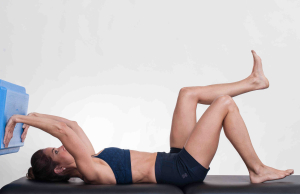How Strong Is Your Core?
What is the Core?
Many of us think of the core as just the “abs”. However, our core is a complex of many muscles in the trunk of the body- like the pelvic floor, transverse abdominis, obliques, erector spinae, psoas major, gluteus maximus, trapezius, and diaphragm. The core acts to stabilize the spine and provide support for all the activities we do. It transfers force through our body, and prevents us from having undesired back, hip, knee and even neck pain.
The Wall Dead Bug

This is one of our favorite core exercises! It is an isometric bracing exercise while using a motion that mimics gait. Pushing the hands into the wall causes the low back to press firmly into the floor and stay in a stable position as you move the legs.
Think of it as a plank with training wheels- using the floor and the wall as support, we are able to create and maintain full body tension.
Beginner? Modify by keeping the knees bent and tapping the heel to the floor.
Ready for a challenge? Straighten the leg and hover a few inches from the floor or add a mini band around the feet for more resistance.
The Psoas Muscle

Whether you run, dance, bike, practice yoga, sit at a desk all day or do the wall dead bug, your psoas is involved! It is the primary connector between the trunk and the lower limbs, and helps stabilize the spine.
Dysfunction in the psoas muscle can not only cause back pain, but may also be linked to leg length discrepancy, knee pain, postural deviations, constipation, menstrual cramps, and even difficulty with deep diaphragmatic breathing.
If you think you may be experiencing issues due to the psoas, it is important to get assessed and begin a plan to recover!
About Love Health
We are sports medicine doctors and specialists ready to help you move better. Contact us today to learn more, or set up an appointment.

